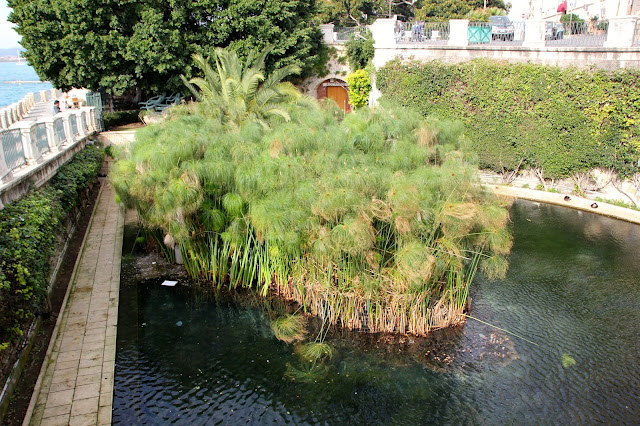November 21, 2015
We spoke in the Palermo Stake Conference held in Siracusa. Prior to the afternoon session, the Stake President took us to the Island of Ortigia to show us some of the unique features of the area.
* * * * *
The Island of Ortigia
The simultaneous presence of a fresh water source and a coastal bay suitable
to protect ships at anchor attracted the Greek colonists of Corinth to the island (at that time still a peninsula) of Ortigia in Sicily in 734-33 B.C.
Here the Greeks founded the city of Syracuse, chasing out the Sicels who had already populated the area for several centuries.
The choice proved to be fortunate, as the newly founded city soon after started
to expand onto the mainland, a set of five articuled principal areas, together
called a "pentapolis". With an overall population on the order of hundreds of thousands of people this
pentapolis represented one of the largest metropolises of the ancient Mediterranean before the days of Roman conquest and decadence.
Ortigia is one of a few centers of the Mediterranean to conserve its ancient
Greek urban framework in such a way as to still be legible on a map. The structure
of the streets, despite more than two millennia of evolution, still respects the
"comb teeth" orientation that radiates from a principal street, the Via Sacra or Sacred Way (known today as the Via Dione), which runs through the center of the island.
* * * * *
|
Duomo
Siracusa's Duomo is one of the town's most celebrated sights. The
building records the many ages of the town. Once it was the Greek Temple
of Athena, with a giant gold statue of the goddess on its roof. The
massive Doric columns of the temple are still visible; rather wonky
after earthquake damage. The wall above the columns along Via Minerva,
with battlements, is Norman in origin, while the fancy Baroque facade
was a replacement after the 1693 earthquake. Inside the Duomo, you can
see more evidence of the temple origins of the building, and
more of the original structure. Those interested in relics can admire
some fetching displays of saints' bones in the chapel to the right of
the main altar, where there are also some appealing fragments of fresco.
* * * * *
Fountain of Arethusa
In ancient Greek myth, the origin of the spring was attributed to the fate of
a nymph, Arethusa, who was transformed by the goddess Artemis into a spring to escape the stalking
courtship of Alpheus (son of the god Oceanus). He, in despair, was in turn transformed into a river
by Zeus and thereby succeeded to finally mix his water with that of Arethusa.
The myth probably attempts to explain the brackish taste of the water that results
from the infiltration of the bordering sea.













































No comments:
Post a Comment